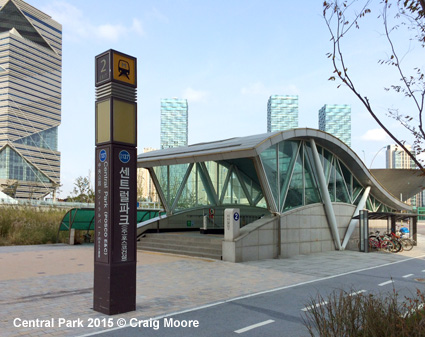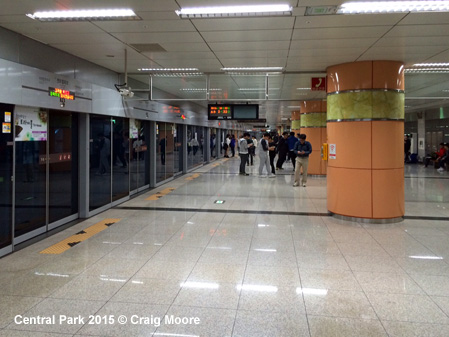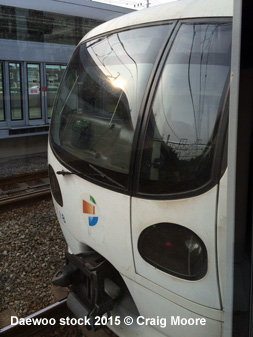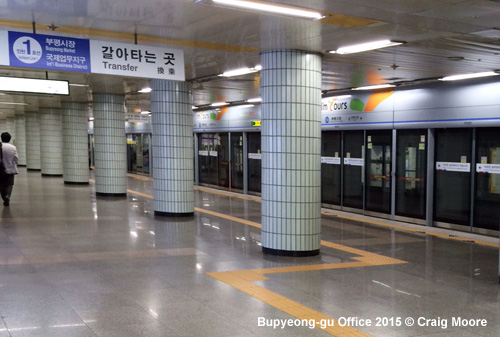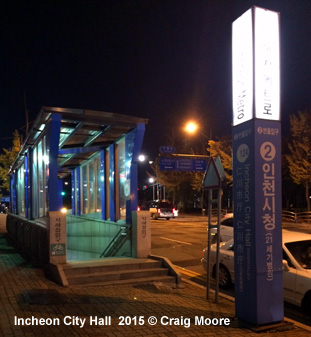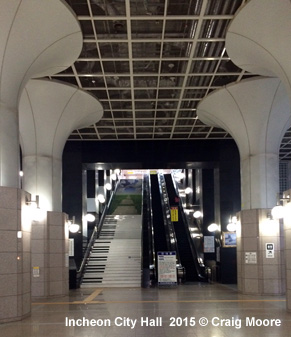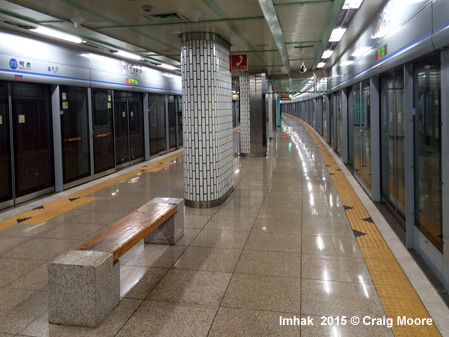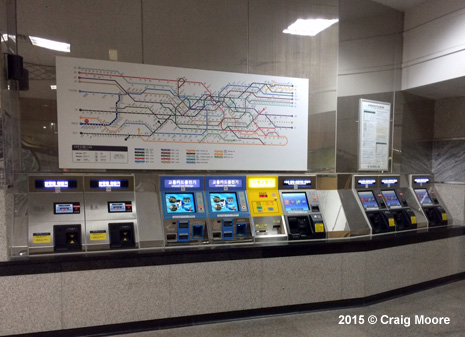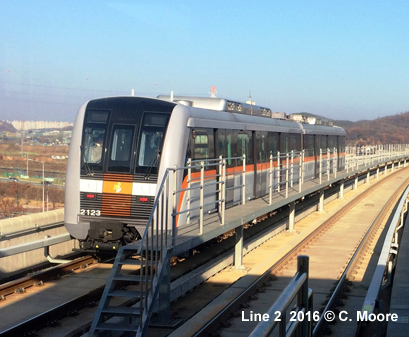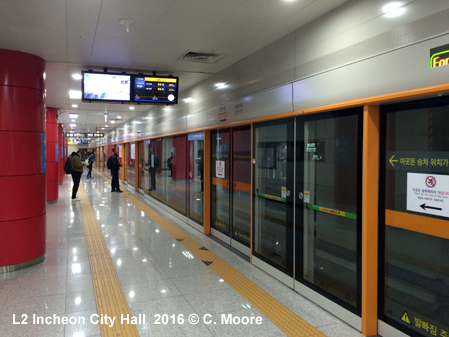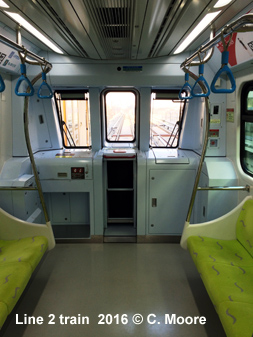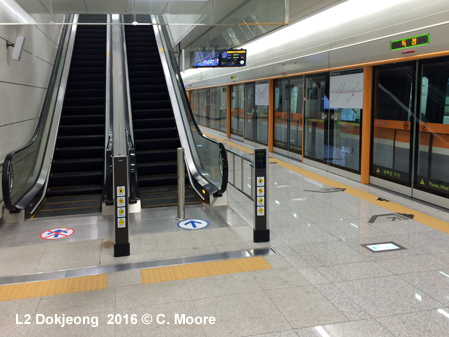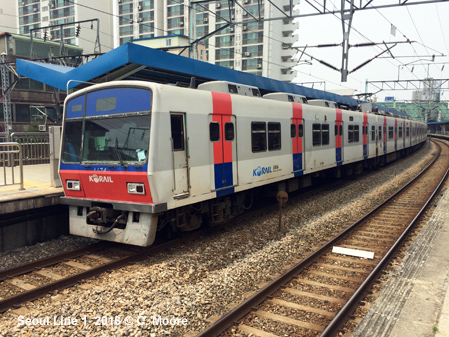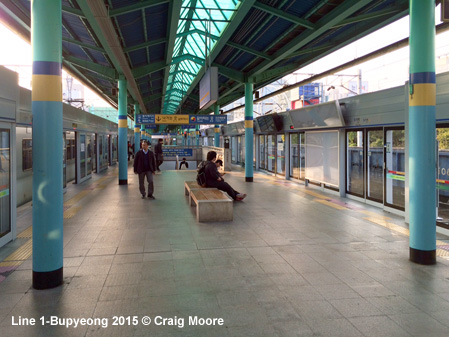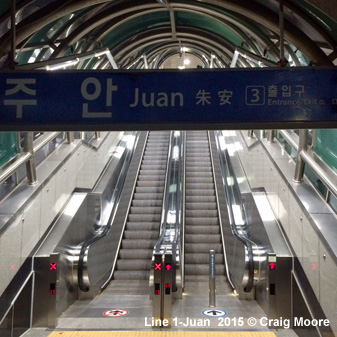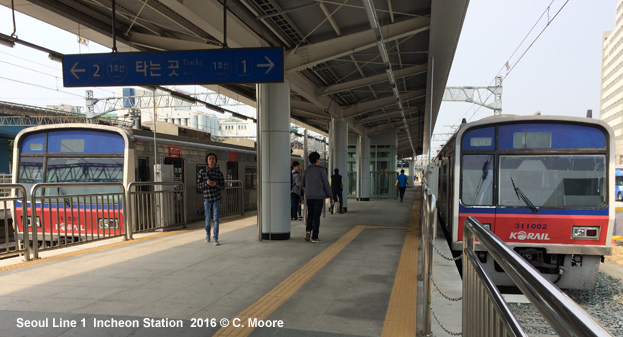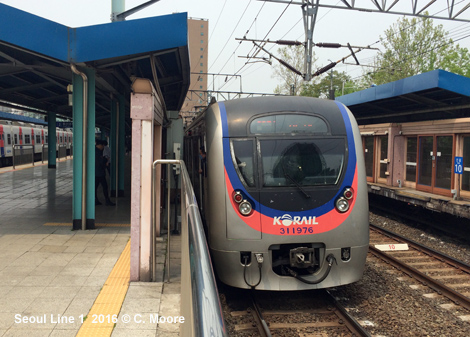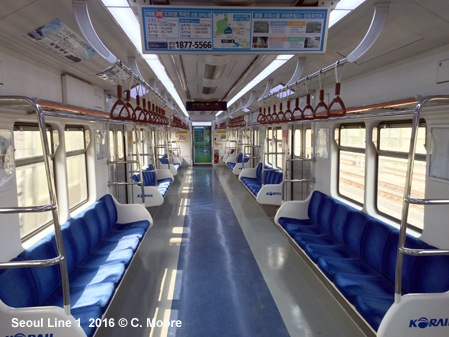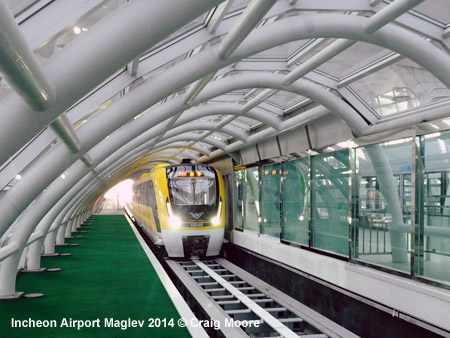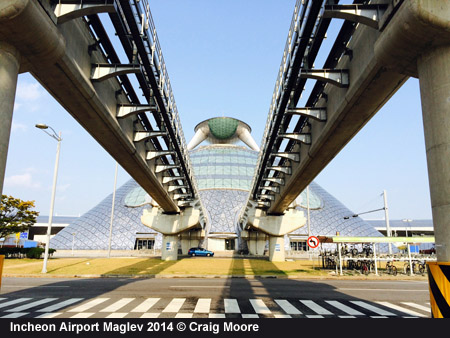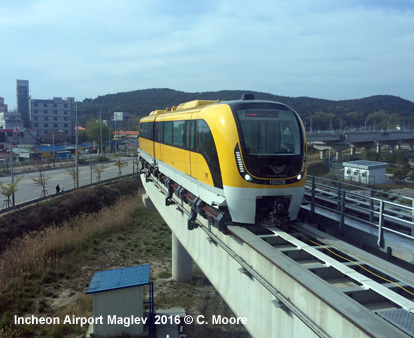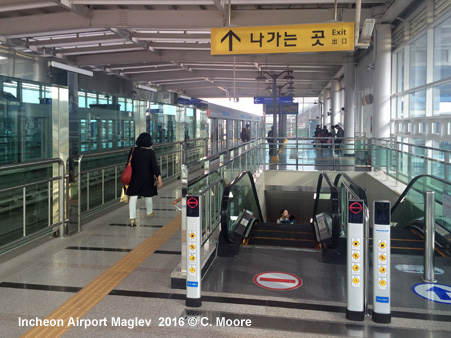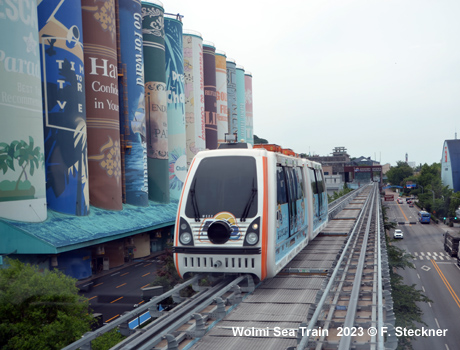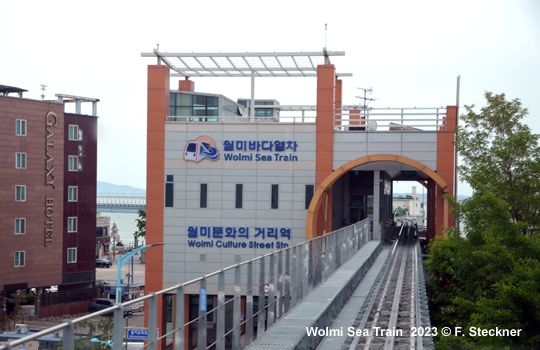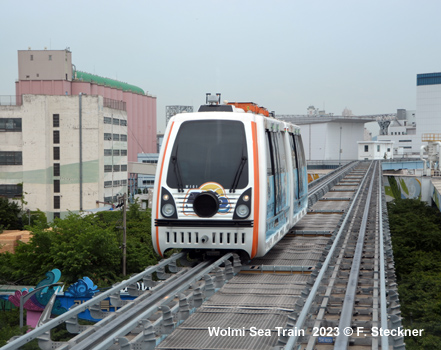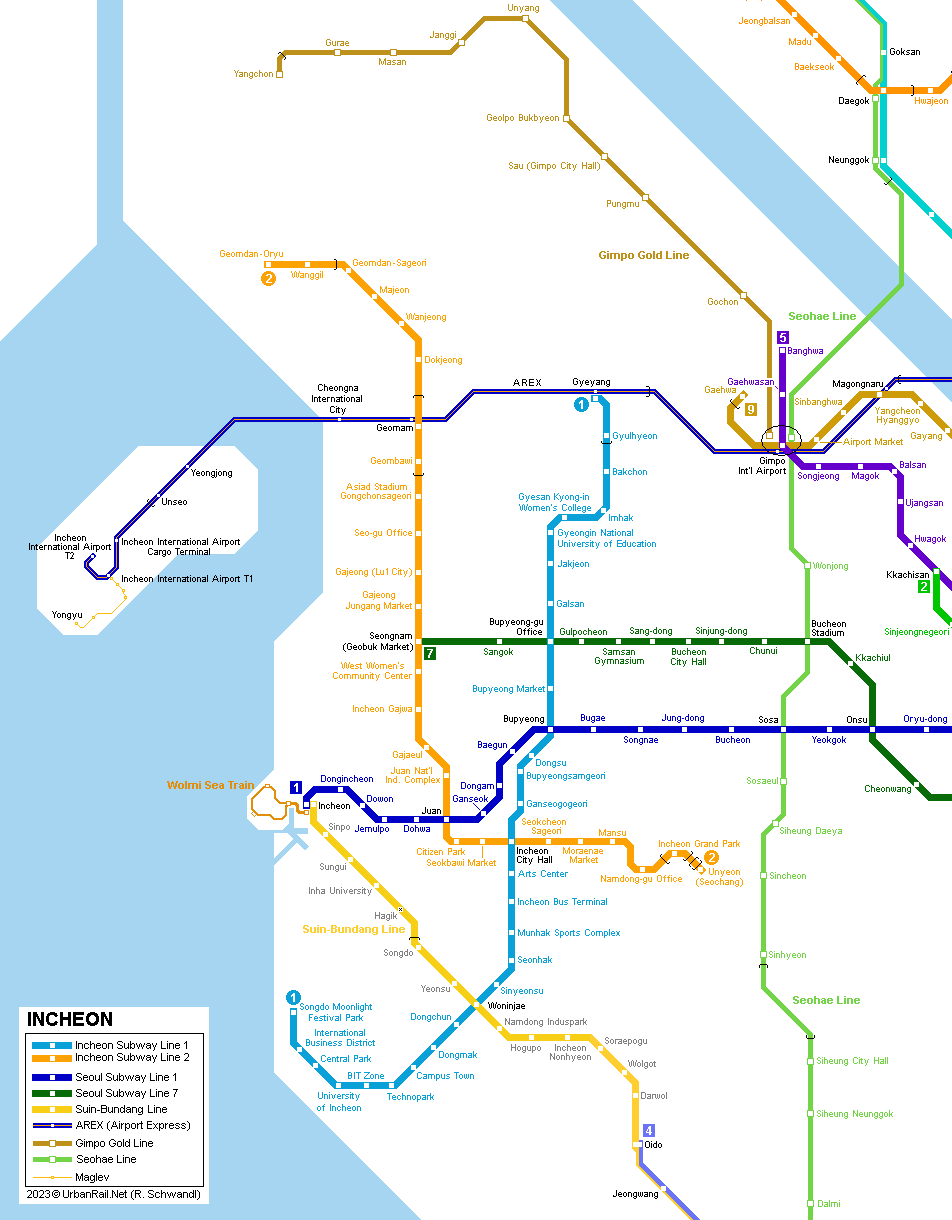
Click on map
to view a rail map for the entire Seoul
region!
| System |
|
Incheon has 2.5 million inhabitants and lies only about 30 km west of Seoul, by the sea. Incheon (In = gentle/Cheon = river) forms part of the Greater Seoul megalopolis that is home to over 20 million people. Travelling between the two cities offers no let up in the dense urban environment and the boundary between the two cities is indistinct. Nonetheless, Incheon is fiercely proud of its separate identity and is classified as the third largest city in South Korea (after Seoul and Busan). As a major port it also has a different feel in the old centre, with a large Chinese area and interesting sites of ancient and 20th century historic significance (it was strategically pivotal during the Korean War). This mix of amalgamation within Greater Seoul and ‘distinctiveness’ is replicated in the urban rail environment. Within the city, seven lines operate. Three of these form part of the western and southern extremities of the Seoul Subway, operating essentially on an east-west axis, whilst in the north-west, the airport area supports the AREX and a short Maglev line. The city itself operates two metro lines – one a full metro, the second a fully automated light metro. A monorail is also in construction at Wolmido. Together, there is a total of 125 km of operational/revenue lines within the city boundary, of which 66.4 km is underground. These lines host 83 stations, 54 of which are underground (4 of these also have above ground platforms). For Seoul's Line 1, Line 7, the Suin Line and the Gimpo Gold Line click here. |
| Incheon Line 1 |
|
Trial runs on the initial Line 1, a 23 km north-south route, started in March 1999. After six years of construction it opened for regular service on 6 October 1999 as the fourth subway system in South Korea after Seoul, Busan and Daegu. A 6.5 km southern extension was added in spring 2009. With a short extension to Songdo Moonlight Festival Park in 2020, it has reached a total length of 30 km in 2020. At Bupyeong transfer is possible to Korean National Railways, a route which is actually integrated into Seoul's subway network as an extension of Seoul's Line 1. At the northern terminus of the Incheon Subway line, at Gyeyang, it connects with the new railway to Incheon International Airport (Incheon Airport Railroad) which opened on 23 March 2007. The Incheon subway is operated by Incheon Rapid Transit Corporation. 06
Oct 1999: Dongmak
–
Bakchon |
|
Incheon Line 2 |
|
Incheon Subway Line 2 opened in summer 2016: 29.3 km (6.1 km above ground, 27 stations); driverless, operating initially with 2-car trains, stations laid out for 4-car trains; interchange with Seoul's Line 7 will be available around 2020 at Seongnam station. [Project Website] 30 July 2016: Oryu-dong - Unyeon
|
| Video |
|
|
| Links |
|
Incheon Rapid Transit Corporation (IRTC - Official Site) Incheon Subway (Korean) Incheon Subway at Wikipedia Incheon Airport Maglev at Wikipedia Kojects (Transport Projects in Korea)
|
| KoRail - Seoul Subway Line 1 & Suin Line |
|
|
| Incheon Airport Maglev |
|
6.1 km, 6 stations Free service between terminal stations started 3 Feb 2016. |
|
|
| Wolmi Sea Train |
|
6.1 km, 4 stations Opened on 8 Oct 2019, this is a single-track loop serving tourist destinations on Wolmi Island, using small rubber-tyred vehicles. |
|
|
| Report |
|
Craig Moore reports from Incheon in Oct. 2015 and Nov. 2016 (update):
Incheon Subway This 2-line system is operated by Incheon Transit Corporation (ITC) and is 58.6km in length (51.9km underground). It has 55 stations, 6 of these offer interchange to lines on the Seoul system. Until 2010, the ICT service had separate ticketing but the line now forms part of the Seoul ticketing system and interchange is barrier-free. This amalgamation is also evident on station and in-train mappage where the Incheon Subway is merely represented as Lines ‘I’ on the complex Seoul-wide map. Since, the opening of Line 2, however, ITC have decided to produce a hard copy schematic of the 2-line network, although this is a pretty dreadful attempt at representing a discrete rail system. There ICT has a smart logo but apart from the odd bit of printed material, the logo can only be seen on the front of the rolling stock - for the most part the Incheon Subway brand is very much part of the Seoul rail family.
ITC Line 1 is a 29.4km line (28.2km underground) opened in 1999 and has 29 stations (27 underground). Stations are very noticeable in the cityscape with smart, broad entrance halls at street level In the past station entrances included the characteristic brown Seoul totem, adorned with station name, station number and yellow and black train icon. Ticket halls are generally light and airy with information office and a bank of 3-4 ticket machines, and a card refund machine. The machines are located below a large illuminated system map of greater Seoul. Fares are distance based and on this line range from 1350 to 2800 Won. A 500 Won refundable fee is charged for the RFID type card ticket which is scanned at the barriers (both in and out). Most of the entrances and exits to the platforms are by stair, although there are lifts and escalators. Most people use the stairs and at Bupyoeng each stair has a calorie count showing you how many have been burnt as you climb (approx 8 calories per set of stairs!). Station platforms vary in style. At the newer southern end, the platforms have a smart modern grey style, whilst those further north have small tiles or different colour schemes but these platforms in particular look dated and unkempt. All platforms have Japanese style schedule posters with the hour column in the middle and the minutes trains arrive during each hour at either side of the central column. Station locality maps, the beautiful Greater Seoul geographic map and exit information are also located on each platform on information boards. Vending machines with gas masks, fire extinguishers and protective garb are also located at strategic points on the platform - a reminder that Pyongyang isn't that far away and that subways in Korea are important parts of the civil defence infrastructure. Although there are electronic information boards located above the full platform screens, frustratingly these do not show when the next train is due (a crude horn bellows when a train is approaching a station). Station names are poster based, often located on pillars and are bright green. These show previous and next station as well as station number. Station names, as well as audio and electronic information on trains are provided in Korean, English (cheesy American) and Mandarin.
Services operate from 0530 to midnight and there is a base headway of 8/9 mins (7 trains per hour) although during peak times 4/5min headways are evident and a journey on the entire line takes 53mins. As for the journey, well the northern terminus at Gyeyang connects with the AREX stopping service between the airport, Gimpo and Seoul Station. The large AREX structure is located parallel to the Incheon Subway station and is connected via a walkway over the tracks. The ICT station is also a substantial elevated structure and is bright and airy. On departure the line turns sharply south and heads down a ramp to Gyulleon station which is at grade and on a curve. This section affords good views of the stabling facility to the east. These are the only two stations on the line that are above ground and both maintain platform screens. The portal is shortly after departure from Gyulleon (total 1.2km above ground) and the remainder of the line is underground. Both Bakchon and Imhak have two side platforms and a narrow island platform in the middle. The rest of the stations are simple two line affairs with side platforms, with the exception of Jakjeon, Sinyeonsu and Dongmak which are island platform stations. This central part of the line has the highest patronage as it runs through the newer civic and commercial area of the city. Around the Bupyeong area the Incheon Subway connects with Line 7 and Line 1 of the Seoul Metro, and at Incheon City Hall there is interchange with the new Incheon Metro Line 2 (see below). These interchanges are signed adequately, although at Bupyeong station the distance from ICT underground platform to the elevated Korail Line 1 platform is significant and rather circuitous, involving stairs, escalators, corridors lined with clothes and food shops and moving walkways. It is also the busiest station on the line. Moving further south the line offers interchange with the new Suin Line (see below) at Woninjae before heading west to the new, and rapidly developing International Business District (regretfully the train destination boards etc refer to this terminus as "Intl Biz District"- oh dear). This area offers a futuristic cityscape and is part of the Korean Governments IFEZ programme.
The stock is made up of the original Daewoo Heavy Industries trains and newer Hyundai Rotem sets from 2008. Both have overhead power supply and offer 8-carriage units (1435 gauge), although all stations have the platform capacity for 10 carriages. The exterior of the stock is white with the smart logo on the front. With side seating and 4 double on each side, the carriages are spacious and the bright interior helps this, although these are festooned with brightly coloured advertising. The Rotem stock has an electric route location indicator above alternate doors whilst the Daewoo stock has an ugly printed line map (with stations in yellow having exit on the left (island platform)). The other doors have the over complex Seoul system map with the ITC line emboldened. Getting the entire system onto a strip map is difficult and very nearly impossible to read and so the emboldened line just gets lost in the mess. However, clear audio and electric information informs passengers of next stop and interchange. The ride is smooth and rapid, and station dwell times are minimal.
ITC Line 2 opened earlier this year (2016) and is a 29.2km fully automated light metro. It has 27 stations (22 underground and 1 in an open cut with part-roof) and operates 6min base headways. The line has standard gauge and is third rail powered, using 2-car Rotem stock (although all stations are built for 4 cars). The stock is smart and clean with cloth covered side seating, LCD route map above doors and Korean/English audio announcements (at transfer stations Mandarin and Japanese audio information is also offered). Being new, the underground stations are very smart with smart station entrances at street level, bright ticket halls and new-style ticket machines and barriers. Accessed by a central escalator, the platforms are quite confined and shallow with small station name signs, platform information boards, side platforms and full screens. The stations have large white tiling and there is a mustard trim to match the line colour designation. In general, the above-ground stations appear much larger, with three-quarter screens and part-covered roofs.
The journey takes 48mins and provides some points of interest. Unyeon Station is located to the north of the sheds and is within an open cut. From here the line is a mix of grade and tunnelled alignment and, as the train heads west there are great views of the built-up city to the north. The line meanders quite a bit and is quite noisy in parts but the tunnel vaulting, and larger underground space near the stations is very clean and bright. This part of Incheon is a lower density housing area than the north and only at Incheon City Hall (ICH) do the trains get full (heading north). ICH provides interchange to ITC Line 1 via a 200m underground walkway. A sharp slow turn north, followed by rapid acceleration brings us to Juan. This station provides Line 2 passengers with barrier-free access to the main Korail Incheon-Seoul Line (Seoul Line 1). The ITC Line 2 platforms lie perpendicular and directly below the large grade Juan Korail station and transfer is very quick, slowed only by the large passenger flows. Moving north, the line is quite swift along the straight alignment to Asiad Stadium, the only difference in view being the triple-tracked section around Seogu Office. From Asiad Stadium Station the line leaves its underground alignment and begins to climb quite steeply (almost Wilhelminaplein/Croix-Paquet levels of incline) and offers great views in both directions (to the north the Arex station and new bridge across the canal, whilst to the south the stadium and city skyline are in view). This section of the line is the most interesting. The incline is almost roller coaster like and when heading north, Geombawi station doesn’t come into view until just before the crest. A less dramatic downward slope to Geonam provides interchange to the Arex Line. This Line 2 station is the largest on the line and is on 3 levels, with transfer to the Arex station taking approx 6mins, including an outside walkway, enclosed within glass walls - there are barriers to the Arex platform which require ticket scan but no additional fare is charged. Northward the line crosses the new, sweeping Han Canal bridge and drops underground again, emerging above ground again before the last stations in the north around Wanggil.
Other lines 30.9km of the AREX line lies within Incheon, with 2 underground stations (6.5km underground) as the line nears the airport. There are two service types - the express runs every 30 mins and the all-stops service running 4-5times per hour. Within Incheon the line runs parallel to the motorway and offers lengthy (barrier free) interchange with the Incheon Subway at Geoman and Gyeyang before crossing into Seoul at Gimpo Airport. The line has some very impressive infrastructure, stations and bridges, especially at the airport with its space aged, if overbuilt building and it is here (three floors above the underground Arex platforms) where you find the terminus of the Airport Maglev line. Branded the EcoBee, because of its black and amber colour-scheme, the service is free and operates at 15min headways between 0900 and 1815. The 6.1km line has 6 stations and serves airport facilities as well as residential and leisure facilities on to the southern part of the island at Yongyu township. The 2-car Rotem stock is smart but the journey is very slow and is currently used purely as a sightseeing trip for beguiling elderly Koreans. Once the massive amount of construction along the route is complete, then the line will have value but at the moment it is a bit of a white elephant.
Only 1.9km of SMRT Line 7 lies within Incheon (3 stations) and this is fully underground. Interchange at Bupyeong-Gu Office Complex is very straightforward through stairs at the southern end of the Incheon line platform. A silver plate at the end of the platform indicates that you are now joining the SMRT system - and you feel the change almost immediately. This is definitely a Seoul line operating at 5min intervals. Line 1 is the most substantial of the Seoul lines to operate in Incheon. From Bugae to Incheon, the 13.7 km (11 stations) section runs at grade through densely populated areas of the city. This line is Korail operated and has 3/4min headways. The line has a mix of express and stopping services with many stations containing 2 island platforms (4 tracks) with separate sides of the platform operating different services. To wait at the end of Bupyeong station at peak hour with the constant movement of trains, packed to the rafters with passengers is a great experience (Guro, Sindorim and Singil further east are also busy and characterful). The route from here to Yongsan in central Seoul is, in my opinion, one of the highlights of urban rail on the planet. At the Incheon end of the line there is lengthy barrier free transfer to the underground Suin line station (see below) and, immediately opposite the dead end suburban style station is the Wolmido Island Monorail. Although the infrastructure is in place there is no sign of any transport activity. When this line begins operation it will be more a 'fun' monorail, visiting entertainment and tourist spots on an island in Incheon harbour.
The Suin Line uses an old narrow gauge alignment, rekindled into an extension of Line 4 in 2012. Its name is a derivation of Seoul (SU) and Incheon (IN) and is thus seen as a joint line, belonging specifically to neither city. Add to this it is operated by the national rail provider (Korail) and locational identity becomes even more blurred. 14.9km of the line is located within Incheon's city boundary (11 stations) and there is free interchange with the Incheon Subway at Woninjae, and with Seoul’s Line 1 at the Incheon terminus. The line runs party elevated and partly at grade through the south eastern area of the city before travelling underground (6.1km) to the centre of old Incheon. This underground section is new and has some interesting station designs including a bricked arcade at Incheon terminus. Services are operated by Class 351 Korail EMUs with overhead power supply. The 6-carriage sets run at 15min headways from 0545 to midnight, and although this frequency is significantly lower than other lines in the Seoul area, patronage levels are quite low and so service levels are appropriate. Certainly, the stations on the line are robust, large structures capable of handling significant movement and stations have been future proofed with beds prepared for additional platforms and passing loops. The ride is fine although speeds are not high and there are long dwell times at stations. |
2004 © UrbanRail.Net by Robert Schwandl.
